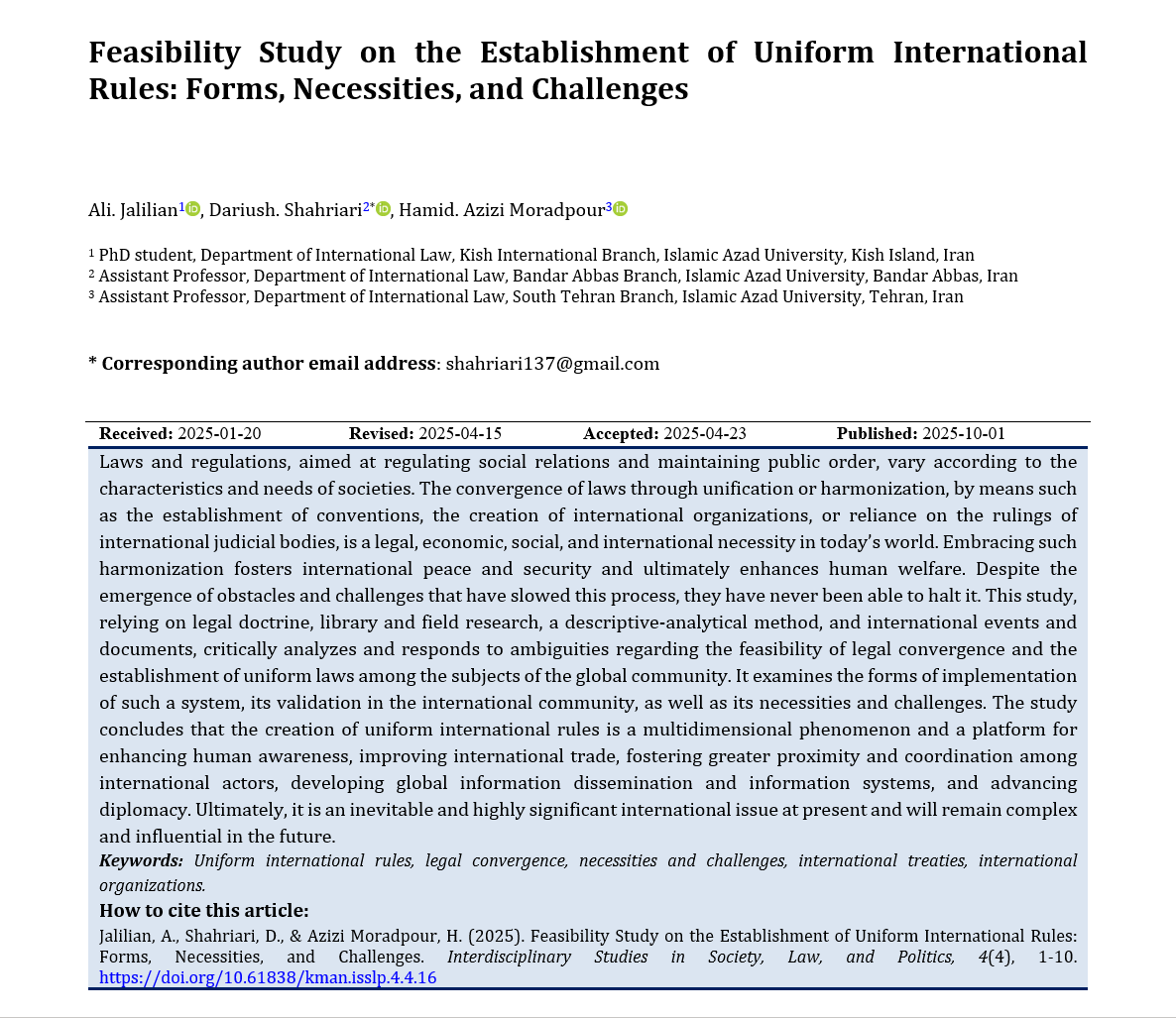Feasibility Study on the Establishment of Uniform International Rules: Forms, Necessities, and Challenges
Keywords:
Uniform international rules, legal convergence, necessities and challenges, international treaties, international organizationsAbstract
Laws and regulations, aimed at regulating social relations and maintaining public order, vary according to the characteristics and needs of societies. The convergence of laws through unification or harmonization, by means such as the establishment of conventions, the creation of international organizations, or reliance on the rulings of international judicial bodies, is a legal, economic, social, and international necessity in today’s world. Embracing such harmonization fosters international peace and security and ultimately enhances human welfare. Despite the emergence of obstacles and challenges that have slowed this process, they have never been able to halt it. This study, relying on legal doctrine, library and field research, a descriptive-analytical method, and international events and documents, critically analyzes and responds to ambiguities regarding the feasibility of legal convergence and the establishment of uniform laws among the subjects of the global community. It examines the forms of implementation of such a system, its validation in the international community, as well as its necessities and challenges. The study concludes that the creation of uniform international rules is a multidimensional phenomenon and a platform for enhancing human awareness, improving international trade, fostering greater proximity and coordination among international actors, developing global information dissemination and information systems, and advancing diplomacy. Ultimately, it is an inevitable and highly significant international issue at present and will remain complex and influential in the future.
Downloads
References
Alizadeh, M., & Rahmani, I. (2016). The necessity of understanding the transformation of the concept of the international community in law and international relations. Contemporary Political Essays, 7(4), 39-21.
Carolis, D. D. (2010). Some features of the harmonization of international trade law in the third millennium. Uniform Law Review, 15, 37-72. https://doi.org/10.1093/ulr/15.1.37
Casanovas, O. (2021). Unity and Pluralism in Public International Law. BRILL.
Červenkovà, L. (2008). Europeanization and unification of private international law
Falsafi, H. (2016). International law of treaties. Tehran: No Publishing.
Fernandez, T. A., & Lopez, G. D. (2017). The impact and consequences of Brexit on acquired rights of EU citizens living in the UK and British citizens living in the EU-27.
Gergia, A. (2007). The right of property under European Convention on Human Rights: A guide to the implementation of the European Convention on Human Rights and its protocols. Human Rights Handbook No 10 Council Of Europe.
Good, R. M. (2007). Acceptance of custom in international commercial law. Legal Journal, 36, 241-201.
Hassanpour, J. (2017). An analysis of the conflict between the principles of humanitarian intervention and national sovereignty. Specialized Quarterly of Political Science, 13(41), 107-185.
Izadi, B. (2007). An introduction to the foreign policy of the Islamic Republic of Iran. Busatan Ketab Publishing.
Jalali, M., & Shakouri, M. (2011). Analysis of the theory of harmonization of international commercial contract law. Legal Research Journal, 20.
Jalali, M., & Shakouri, M. (2013). The process of harmonization of contract law at the international level. Private Law Research, 2(3), 177-151.
Kadkhodaei, A. (2001). Structure and law of the European Union. Tehran: Mizaan Publishing.
Kelly, C. (2008). Institutional alliances and derivative legitimacy. Michigan Journal of International Law, 29.
Montesquieu, & Mohtadi, A. A. (1983). The spirit of the laws. Tehran: Amir Kabir Publishing.
Mousazadeh, R. (2016). International organizations. Tehran: Mizaan Publishing.
Nicholson, F. J. (1965). The protection of foreign property under customary international law. Boston College Law Review, 6(3), 391-415.
Perrone, N. M. (2014). The international investment regime and foreign investor rights: Another view of a popular story. Journal of International Economic Law.
Safari Pajooh, M. (2015). The right to peace and economic globalization. Tehran: Payam Publishing.
Salehi, J., & Razavi Mobarqa, S. K. (2017). National interests in theoretical perspective. Political and International Studies Research, 8(30), 149-125.
Shapira, J., & Askini, R. (1992). International commercial law. Tehran: Islamic Revolution Publishing and Training.
Shiravi, A. H. (2005). Comparative law. Tehran: Samt Publishing.
Tavakolifard, M. (2001). The process of globalization in criminal law. Modares Quarterly, 5(4), 58-37.
Voitovich, S. A. (1994). International economic organizations in the international legal process. Martinus Nijhoff Publishers. https://doi.org/10.1163/9789004634626

Downloads
Additional Files
Published
Submitted
Revised
Accepted
Issue
Section
License
Copyright (c) 2025 Ali Jalilian, Dariush Shahriari, Hamid Azizi Moradpour (Author)

This work is licensed under a Creative Commons Attribution-NonCommercial 4.0 International License.





